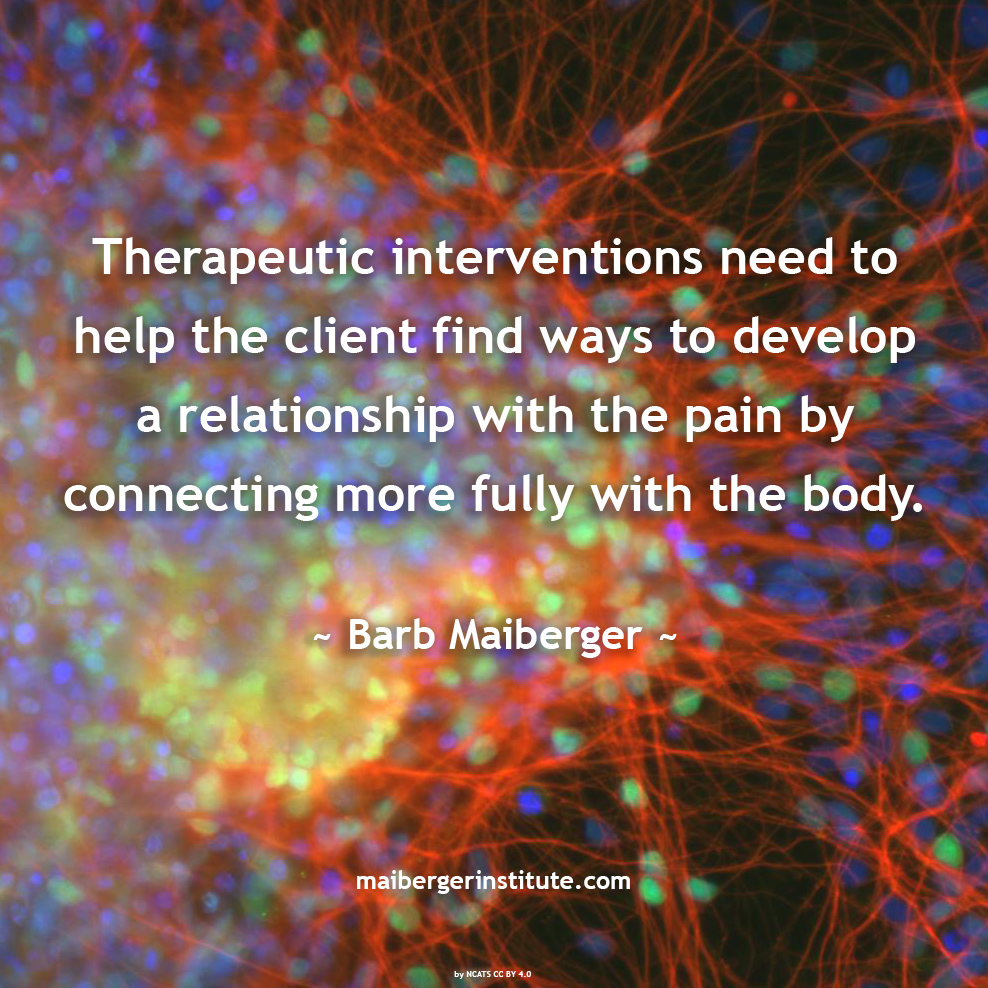
“Therapeutic interventions need to help the client find ways to develop a relationship with the pain by connecting more fully with the body.”
~ Barb Maiberger ~
Chronic pain is a silent epidemic that effects millions of people and can impact them cognitively, emotionally, physically, and even spiritually. The tendency when experiencing pain is to retreat, isolate from other people and even lose one’s enjoyment in life, which can be debilitating. Part of the process in relationship to the pain is to disconnect from the body in order to not feel so much pain. When we experience pain, the body’s response is to contract around the pain for protection. This process actually can end up increasing the level of pain, sending more signals to the brain and body that more protection is needed. Negative thinking can take over and clients can feel out of control, powerless, helpless and look for quick fixes to take their pain away.
When clients are in chronic pain and come in for psychotherapy, they may feel like they are crazy and that there is no hope for them. Therapeutic interventions need to help the client find ways to develop a relationship with the pain by connecting more fully with the body. Getting to know this pain more deeply can provide information that can be helpful in how to navigate and move through daily life, finding more functional ways to be with the pain.
At TEDxEmory, Fadel Zeidan spoke about how he works in a pain treatment clinic to help people with chronic pain learn different ways to manage their pain. The TEDxTalks was titled, “A Different Approach to Pain Management: Mindfulness Meditation.” This talk caught my attention because of the research that he was conducting to see the efficacy of mindfulness practice in relationship to pain management.
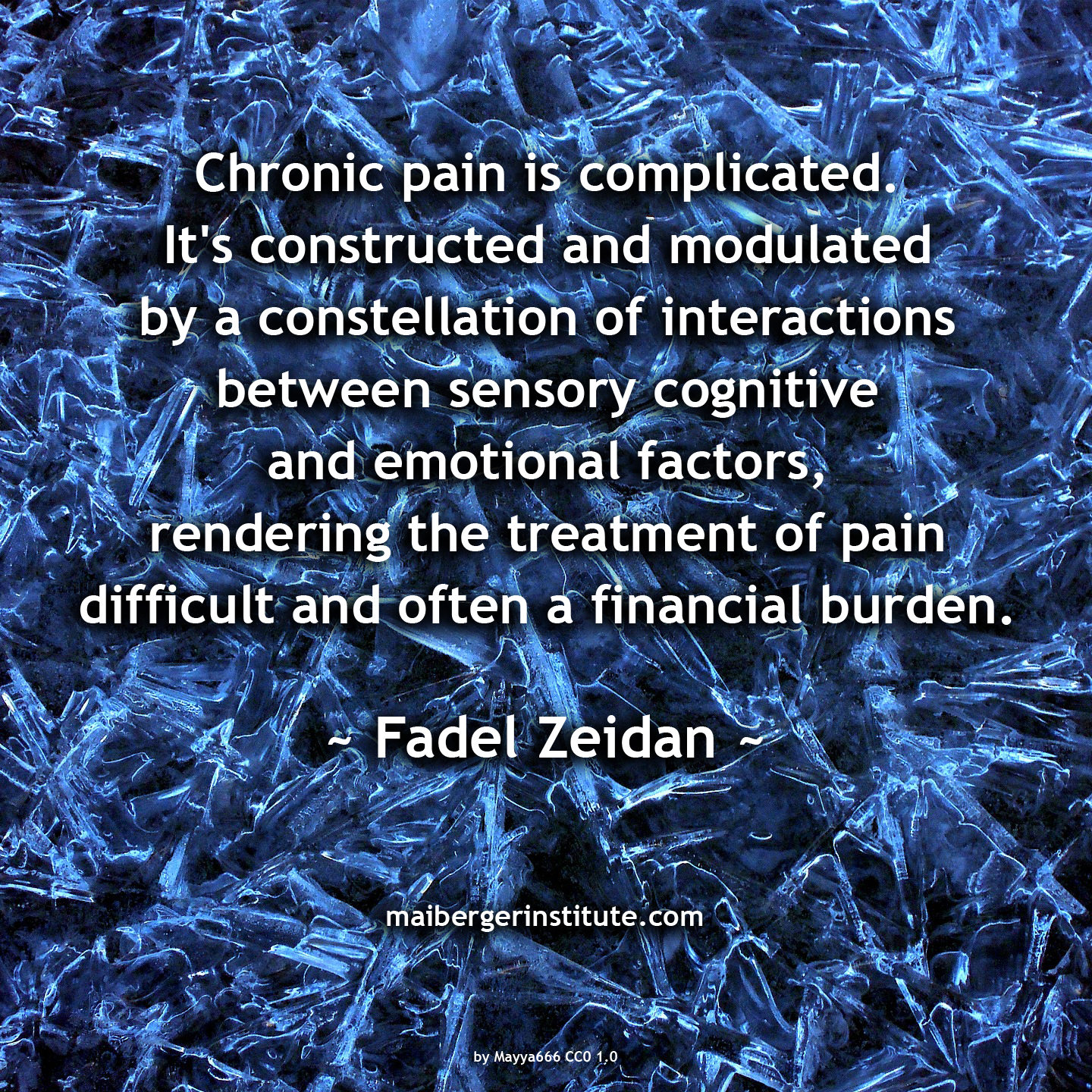
“Chronic pain is complicated. It’s constructed and modulated by a constellation of interactions between sensory cognitive and emotional factors, rendering the treatment of pain difficult and often a financial burden.”
~ Fadel Zeidan ~
In his work, Zeidan conducted a study where people struggling with asthma were divided into two groups: one group meditated for four days for 20 minutes a day, and the other group only thought they were meditating four days for 20 minutes a day but they actually weren’t. What the research showed was that the group that was actually meditating those four days found that their pain level reduced 40%, and the other group that thought they were meditating everyday but actually weren’t found their pain was reduced by 24%. What is really interesting about his work, is that he found that giving patients morphine only reduced their pain by 20%!
Now this work is amazing to see because in our culture we are constantly seeking a quick fix to take pain away. In our country, right now we are experiencing an epidemic of opioid use as people are finding themselves addicted to medication to take the pain away, and it isn’t working! If you look at the National Institute on Drug Abuse statistics, they report that 130 people die every day from an over dose of opioids and many of this comes from prescription-based treatment. This makes Zeidan’s research all the more interesting, that mindfulness is a key component to working and treating chronic pain.
Mindfulness happens to be one of the key components of somatic psychology and EMDR therapy. When these modalities are combined, it can create a powerful way of working and treating clients who are experiencing chronic pain. In our book, “EMDR Therapy and Somatic Psychology: Interventions to Enhance Trauma Treatment,” Dr. Arielle Schwartz and I devote a chapter on how to work with Chronic Pain and Illness from a somatic perspective. Our work includes several mindfulness exercises to help clients get in touch with their pain and begin to develop a healthier relationship with their pain, along with how to successfully apply EMDR therapy to trauma and related pain the client may be experiencing.
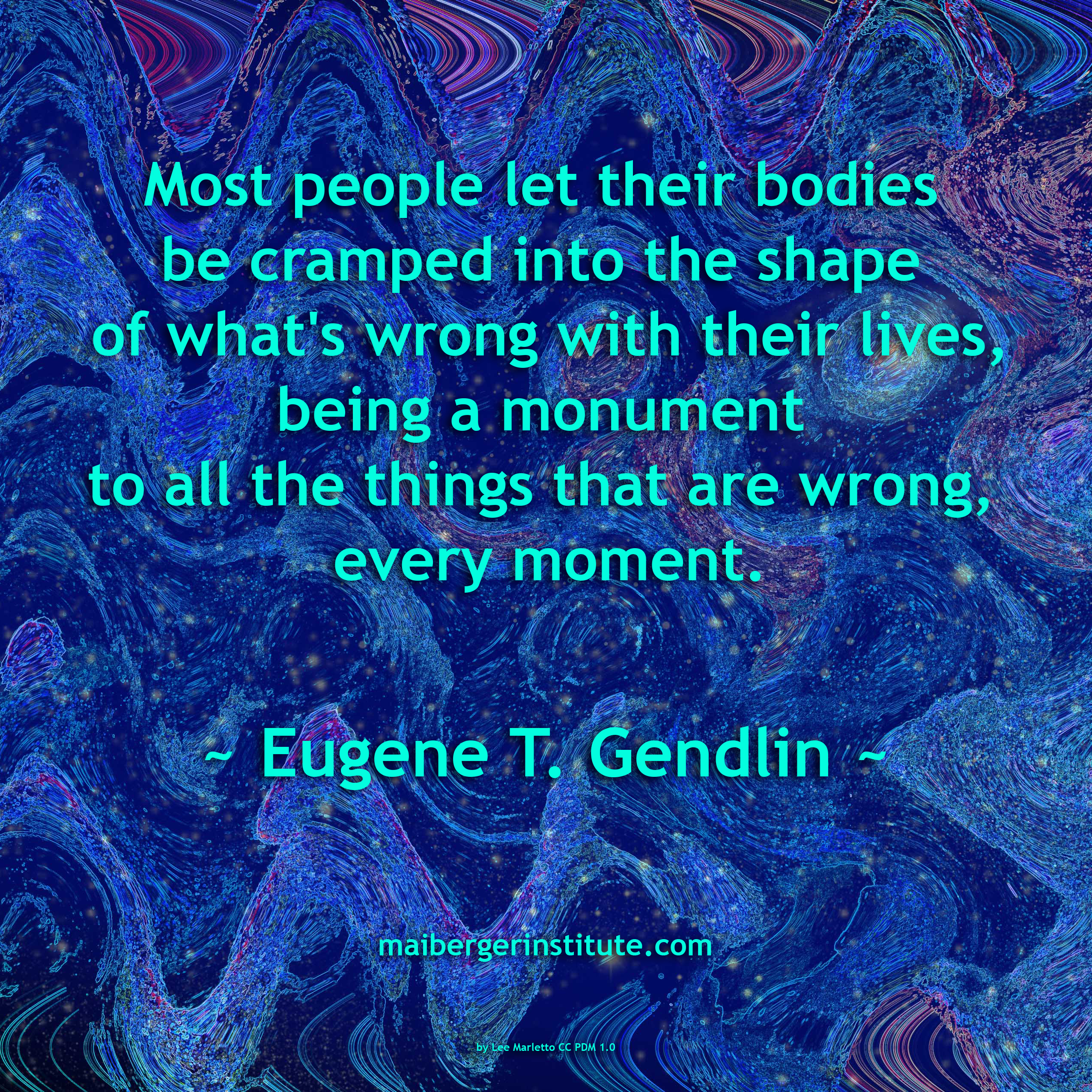
“Most people let their bodies be cramped into the shape of what’s wrong with their lives, being a monument to all the things that are wrong, every moment.”
~ Eugene T. Gendlin ~
One of the interventions in our book is based on Eugene Gendlin‘s work called “Focusing.” The goal is to listen to the pain and see what wisdom the pain has to offer the client. To begin this mindfulness-based exploration, the therapist needs to create a safe place for the client to slow down, be quiet and listen to their pain. In order to listen, the client must practice observing the sensations of the pain with descriptive words that are not judgmental. Examples of descriptive language might be: sharp, cold, hot, tingling, prickly. Judgmental words would include language like: bad, wrong, terrible, horrific. The descriptive words help the client develop an ability to observe and feel without all the judgement, which can lead to more pain, contraction, and escaping the body. As the client observes, they begin to notice what it’s like to not fix the pain, or try to make it go away, or control it. Their job is to just notice the pain and be with the pain. As the exercise continues, the client begins to deepen their relationship to the pain by getting to know it with questions that elicit the client’s truth.
Examples of questions that can be asked include:
- “What is the most important part of this feeling or sensation?”
- “What is the worst part of this feeling?”
- “What does this feeling need?”
- “What actions need to be taken?”
- “How would your body feel if this were resolved?”
After these questions have been explored, the client can begin to notice if anything positive has occurred or maybe even a release of some of the pain. Underlying traumas that might be connected to the pain can emerge and be eventually processed through EMDR therapy. Often, I have seen a client’s pain reduce immensely or even go away completely after EMDR therapy. Clients begin to reclaim their bodies, thoughts, feelings, and begin to get back into their lives more fully.
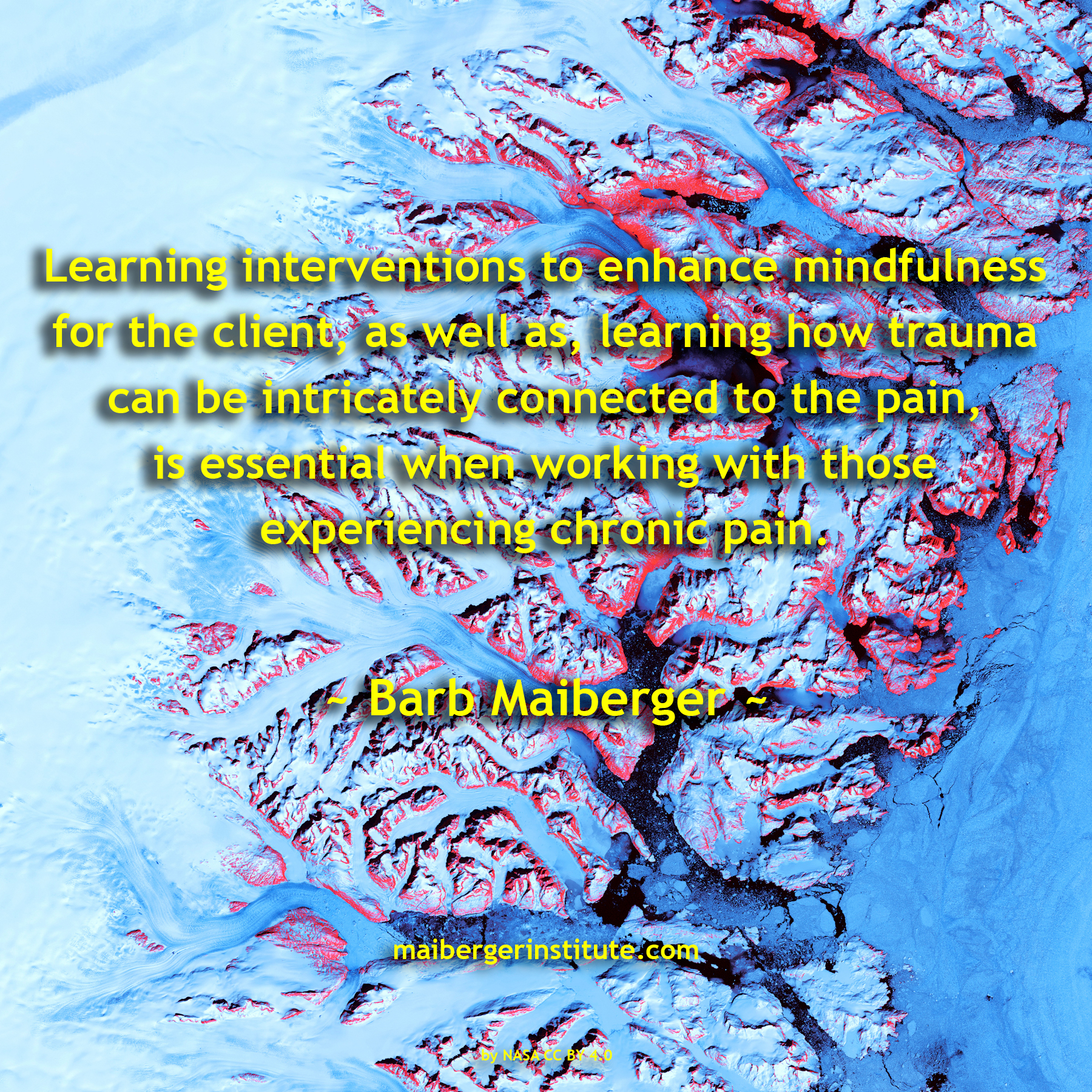
“Learning interventions to enhance mindfulness for the client, as well as, learning how trauma can be intricately connected to the pain, is essential when working with those experiencing chronic pain.”
~ Barb Maiberger ~
Therapists often lack the somatic skills to help clients with their chronic pain, not knowing how to work with the body in relationship to stuck thoughts, feelings and body sensations. Learning interventions to enhance mindfulness for the client, as well as, learning how trauma can be intricately connected to the pain, is essential when working with those experiencing chronic pain. There is hope and we can change the silent epidemic of chronic pain if doctors, nurses, and therapists begin to learn how to work with pain from a more holistic perspective, and approach chronic pain cognitively, emotionally, physically, and spiritually.
About Barb Maiberger, MA, LPC
 Barb Maiberger, MA, LPC is the founder of the Maiberger Institute, and the author of “EMDR Essentials: A Guide for Clients and Therapists” and the co-author of “EMDR Therapy and Somatic Psychology: Interventions to Enhance Embodiment in Trauma Treatment.” Barb Maiberger is an EMDRIA Approved Consultant, and an EMDRIA Certified EMDR Therapist. Barb Maiberger is the CE Program Administrator for the Maiberger Institute. She is a Licensed Professional Counselor in the State of Colorado and has a Masters degree in Somatic Psychology. Barb’s knowledge, experience, keen sense of empathy, and a strong presence have motivated hundreds therapists to incorporate EMDR Therapy into their practices.
Barb Maiberger, MA, LPC is the founder of the Maiberger Institute, and the author of “EMDR Essentials: A Guide for Clients and Therapists” and the co-author of “EMDR Therapy and Somatic Psychology: Interventions to Enhance Embodiment in Trauma Treatment.” Barb Maiberger is an EMDRIA Approved Consultant, and an EMDRIA Certified EMDR Therapist. Barb Maiberger is the CE Program Administrator for the Maiberger Institute. She is a Licensed Professional Counselor in the State of Colorado and has a Masters degree in Somatic Psychology. Barb’s knowledge, experience, keen sense of empathy, and a strong presence have motivated hundreds therapists to incorporate EMDR Therapy into their practices.
Learn More About Barb Read “EMDR Essentials”
“A Different Approach To Pain Management: Mindfulness Meditation” | Fadel Zeidan | TEDxEmory
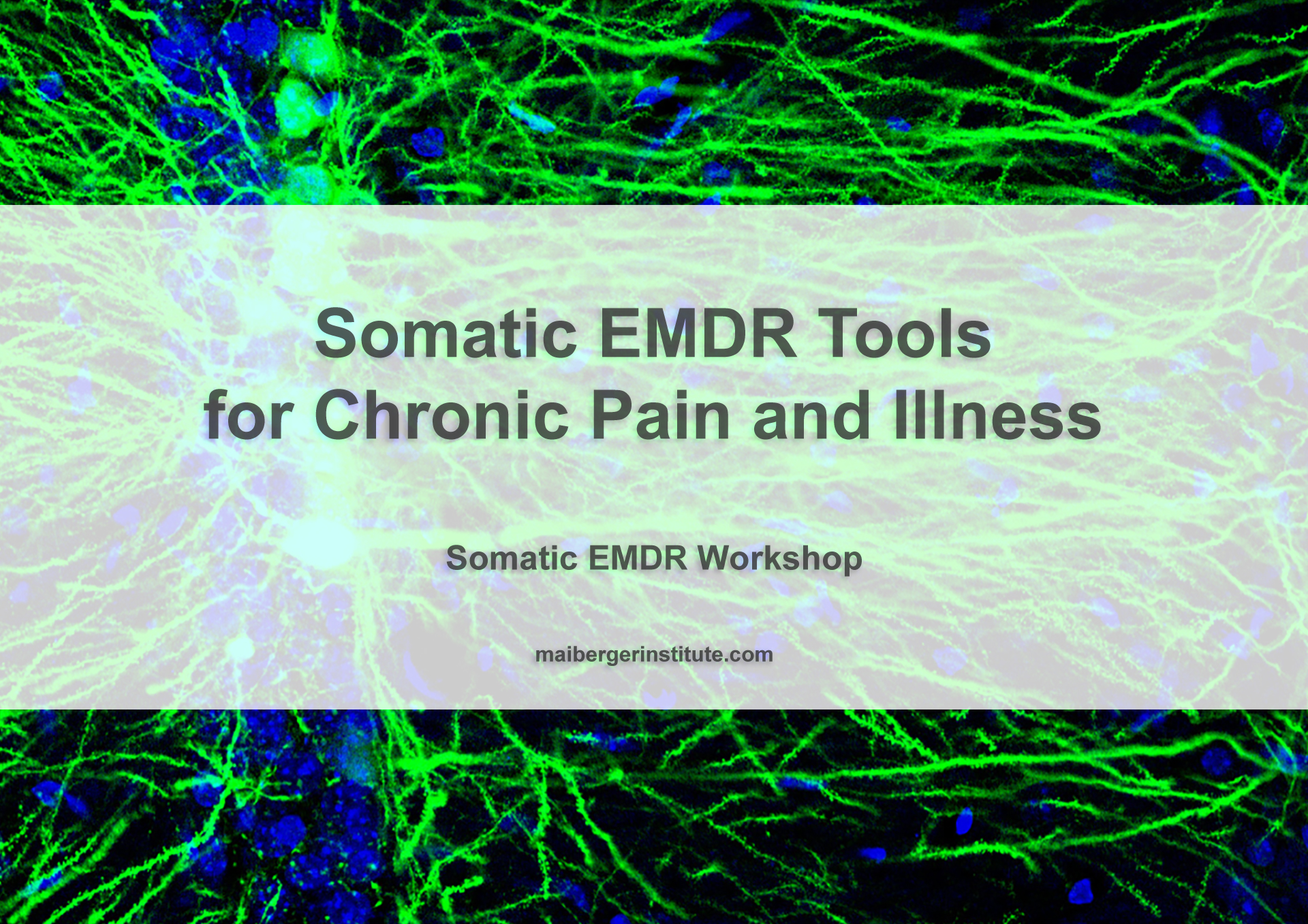 Somatic EMDR Tools for Chronic Pain and Illness
Somatic EMDR Tools for Chronic Pain and Illness
This two-day EMDRIA approved Somatic EMDR Workshop applies the 8 Phases of EMDR Therapy to working with Chronic Pain and Illness. Therapists will learn about the relationship between childhood trauma and chronic illness (ACE study) and how to assess for related EMDR targets with clients. This course will review the neuroscience that underlies stress, chronic PTSD and illness. Experiential exercises will be explored for building affect tolerance through resource development installation and desensitizing targets related to pain and illness. Therapists will be introduced to body centered interventions including trauma sensitive yoga as integrated with EMDR Therapy. The weekend will include time for case discussion and application.
Learn More About This Workshop
Image Source: “Neurons from Stem Cells” ~ by NCATS (CC BY 4.0), “Texture Ice Winter Patterns Crystal Background” by Mayya666 (CC0 1.0), “Nebula Glow Waves” by Lee Marletto (CC PDM 1.0), “Along the southeastern coast of Greenland, an intricate network of fjords funnels glacial ice to the Atlantic Ocean.” ~ by NASA (CC BY 4.0)





